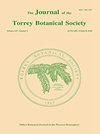Influence of mound building and selective seed predation by the red imported fire ant (Solenopsis invicta) on an old-field plant assemblage
IF 0.8
4区 生物学
Q4 PLANT SCIENCES
引用次数: 25
Abstract
In seed predation experiments, ragweed seeds were selected less often than those of four other early successional species: pigweed (Amaranthus retroflexus), bluegrass (Poa annua), common lamb's quarters (Chenopodium album), and goldenrod (Solidago altissima). Moreover, fire ants selected both larger and smaller seeds than those of ragweed indicating that selection was not driven by relative seed size. There was an increase in the number of ragweed seeds removed by fire ants as the summer progressed, suggesting that more ragweed seeds were incorporated into the diet of fire ants as other species of seeds became less abundant. Lastly, nearly all seeds of pigweed (a preferred species) placed 1, 2, 3 and 4 meters from ant mounds were consumed, which suggests that fire ants may effectively forage the entire field. Both fire ants and ragweed are early successional species that rapidly invade disturbed areas created by humans and natural events. Fire ants significantly contributed to the success of ragweed plants growing in an old field community.红火蚁筑丘和选择性捕食种子对老田植物群落的影响
在种子捕食实验中,豚草的种子被选择的频率低于其他四种早期演替物种:藜草(Amaranthus retroflexus)、蓝草(Poa annua)、羊蹄草(Chenopodium album)和金菊(Solidago altissima)。此外,与豚草相比,火蚁选择了更大和更小的种子,这表明选择不是由相对种子大小驱动的。随着夏季的推进,火蚁清除的豚草种子数量有所增加,这表明随着其他种类的种子变得越来越少,更多的豚草种子被纳入了火蚁的饮食。最后,放置在离蚁丘1、2、3和4米远的pigweed(一种首选种)几乎所有的种子都被消耗掉了,这表明火蚁可以有效地在整个田地里觅食。火蚁和豚草都是早期演替物种,它们会迅速入侵受人类和自然事件干扰的地区。在一个古老的田野群落中,火蚁对豚草植物的成功生长做出了重大贡献。
本文章由计算机程序翻译,如有差异,请以英文原文为准。
求助全文
约1分钟内获得全文
求助全文
来源期刊
CiteScore
0.70
自引率
0.00%
发文量
16
审稿时长
>12 weeks
期刊介绍:
The Journal of the Torrey Botanical Society (until 1997 the Bulletin of the Torrey Botanical Club), the oldest botanical journal in the Americas, has as its primary goal the dissemination of scientific knowledge about plants (including thallopyhtes and fungi). It publishes basic research in all areas of plant biology, except horticulture, with an emphasis on research done in, and about plants of, the Western Hemisphere.

 求助内容:
求助内容: 应助结果提醒方式:
应助结果提醒方式:


